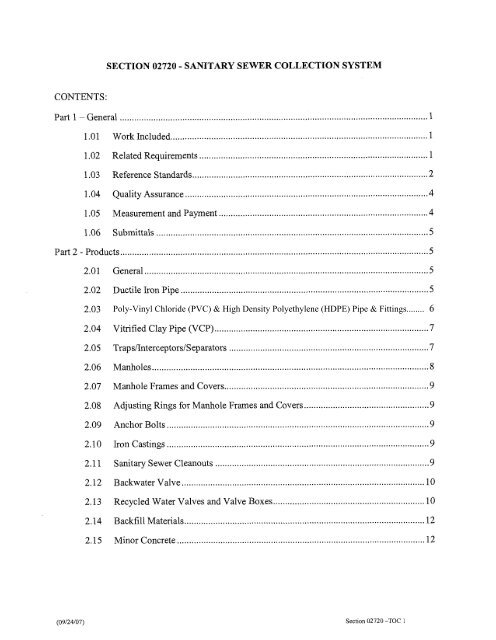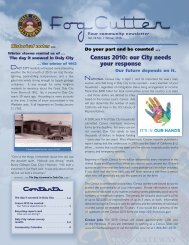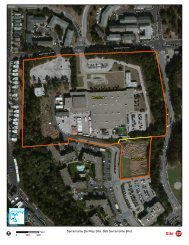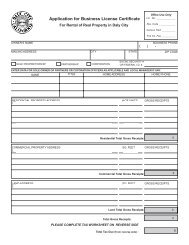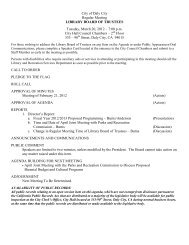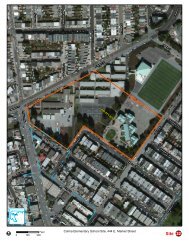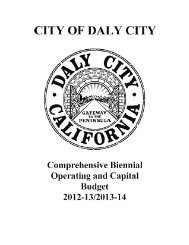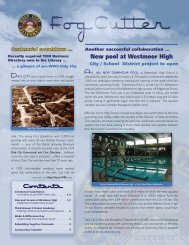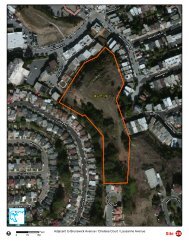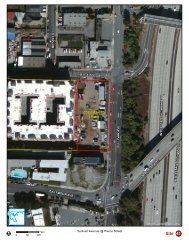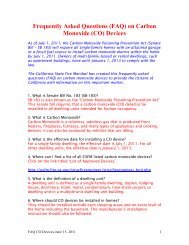02720 Sanitary Sewer Collection System - City of Daly City
02720 Sanitary Sewer Collection System - City of Daly City
02720 Sanitary Sewer Collection System - City of Daly City
Create successful ePaper yourself
Turn your PDF publications into a flip-book with our unique Google optimized e-Paper software.
SECTION <strong>02720</strong> - SANITARY SEWER COLLECTION SYSTEMPART 1 - GENERAL1 .O1 WORK INCLUDEDA. Furnish and install all piping as shown on the drawings, described in thespecifications, and as required for a complete and operable system. The workincludes abandoning and plugging <strong>of</strong> existing main sanitary sewers, construction <strong>of</strong>new service mains and laterals, construction <strong>of</strong> new manholes, appurtenances,demolition and backfilling <strong>of</strong> existing manholes, verification <strong>of</strong> rim and invertelevations, as built drawings, piping for recycled water, use <strong>of</strong> approved confinedspace equipment, trench shoring per OSHA requirements, and compliance with SanFrancisco Bay Area <strong>Sanitary</strong> <strong>Sewer</strong> Overflow Monitoring and Reporting Programrequirements.B. Any and all work to be performed on the <strong>Collection</strong> <strong>System</strong> shall be inspected bythe <strong>City</strong>'s Project Inspector. The <strong>City</strong>'s Project Inspector shall obtain requiredapprovals from DWWR representative for all submittals and inspections.C. In addition, any and all work performed on the collection systems shall conform tothe North San Mateo County Sanitation District code <strong>of</strong> requirements.D. Stormwater Pollution Prevention Requirements - The contractor shall comply withthe <strong>City</strong>'s NPDES Stormwater Waste Discharge permit #CA0029921, as updated,for discharges to the storm drain system, including adherence to all applicable BestManagement Practices to prevent pollutants, including sediment, from entering thestorm drains.The developer/contractor shall provide an adequate Stormwater PollutionPrevention Plan (SWPPP) for all applicable projects prior to commencing anyphase <strong>of</strong> construction. The SWPPP shall comply with the current General Permitfor Construction Activity from the California Regional Water Quality ControlBoard and/or current San Mateo Countywide Water Pollution Prevention Programpermit.1.02 RELATED REQUIREMENTSA. Section 0 1340, "Submittals"B. Section 02221, "Trench Excavation and Backfill"C. Section 03300, "Minor Concrete"Section <strong>02720</strong> - 1
R. ASTM D 3567S. ASTMD 3681U. ASTM D 1784V. ASTM D 3034W. ASTM D 3212X. ASTM D 2321Y. ASTM D 2657Z. ASTMD 3350AA. ASTM F 1803BB. ASTM F 679CC. ASTM F 477DD. ASTMF714EE. ASTMF 477FF. ASTMF585GG. AWWA C950Standard Practice for Determining Dimensions <strong>of</strong> Fiberglass(Glass-Fiber-Reinforced Thermosetting Resin) Pipe and Fittings.Standard Test Method for Chemical Resistance <strong>of</strong> Fiberglass(Glass-Fiber-Reinforced Thermosetting Resin) Pipe in a DeflectedCondition.Standard Specification for Fiberglass (Glass-Fiber-ReinforcedThermosetting Resin) Pipe Joints Using Flexible ElastomericSeals.Rigid Poly (Vinyl Chloride) (PVC) Compounds and ChlorinatedPoly (Vinyl Chloride) (CPVC) Compounds.Standard Specifications for Type PSM Poly (Vinyl Chloride)(PVC) <strong>Sewer</strong> Pipe and FittingsJoints for Drain and <strong>Sewer</strong> Plastic Pipes Using FlexibleElastomeric Seals.Standard Practice for Underground Installation <strong>of</strong> FlexibleThermoplastic <strong>Sewer</strong> PipeStandard Practice for Heat-Joining Polyolefin Pipe and FittingsStandard Specification for Polyethylene (PE) Plastic Pipe andFittings MaterialsStandard Specification for Poly (Vinyl Chloride) (PVC) ClosedPr<strong>of</strong>ile Gravity Pipe and Fittings Based on Controlled InsideDiameter"All Standards Applicable for SDR35, SDR26, SDR21 Pipe andFittings""Standard Specification for Elastomeric Seals (Gaskets) for JoiningPlastic Pipe""Standard Specification for Polyethylene Plastic Pipe (SDR-PR).Based on Outside Diameter"Standard Specification for Elastomeric Seals (Gaskets) for JoiningPlastic Pipe.Standard Practice for Insertion <strong>of</strong> Flexible Polyethylene Pipe intoExisting <strong>Sewer</strong>sFiberglass Pressure Pipe.Section <strong>02720</strong> - 3
1.04 QUALITY ASSURANCEA. All materials and equipment furnished under this Section shall:1. be <strong>of</strong> a manufacturer who has been regularly engaged in the design andmanufacture <strong>of</strong> the materials and equipment for at least five (5) years; and2. be approved by the <strong>City</strong>'s Project Inspector before installation. Theinspector shall verify that the quality is equal to the materials andequipment made by those manufacturers specifically named herein, if analternate product manufacturer is proposed.B. The Contractor's attention is directed to Article 8 <strong>of</strong> the <strong>City</strong>'s General Conditions(Section 00700). To validate that specified final elevations have been provided, theContractor shall provide to the <strong>City</strong> applicable grade certificates as required byArticle 8. No separate payment will be made for providing such certification. Allcosts therefore shall be included in the various work item(s) requiring certification.1.05 MEASUREMENT AND PAYMENTA. The lengths <strong>of</strong> the various types and sizes <strong>of</strong> sewer pipes will be measured and paidfor by the linear foot <strong>of</strong> horizontal length actually installed. Pipe lengths betweenmanholes will be measured and paid only between interior faces <strong>of</strong> manholes.B. Unless otherwise specified in the Special Provisions, no separate payment will bemade for bends, wyes, tees and other fittings. All associated costs therefore shall beincluded in the unit price for pipe requiring the fitting.C. Laterals will be determined and paid for as unit installed in place for the differentsizes <strong>of</strong> laterals or as specified in the Special Provisions. Laterals designated fortransfer fiom an existing sewer main to a new sewer main will be paid as units.D. Manholes, including fiames and covers, will be measured and paid for as unit priceeach. Existing manhole covers shall be salvaged and delivered to the <strong>City</strong> asdirected by the <strong>City</strong>'s Project Inspector unless specified to be reused in the project.E. Potholing will be determined and paid for as unit price each, unless otherwisespecified in the Bid Schedule.F. The above prices and payments shall include full compensation for furnishing alllabor, materials, tools, equipment, confined space equipment and use there<strong>of</strong>,testing, inspections, including probing and locating other utilities, excavation,backfill, aggregate base, pavement restoration, sidewalk restoration, sheeting andshoring, ditching, diking, pumping, bailing, draining, furnishing and maintainingservices and equipment for traffic safety and dewatering, and incidental work forproperly and safely constructing, replacing, or upgrading sewers, complete in placeand fully functional, as shown on the plans and as specified in these specifications.Section <strong>02720</strong> - 4 (09124107)
1.06 SUBMITTALSA. Shop Drawings: Submit data to show that the product conforms to the specificationrequirements.B. Materials List: Submit a list <strong>of</strong> all materials proposed to be used on the project,showing manufacturer's name, product trade name, type, grade, and weight.Materials list shall be submitted and approved before any installation occurs.C. Manufacturer's Warranty: Submit manufacturer's warranty on the product and acertificate showing compliance with applicable ASTM Standards.PART 2 - PRODUCTS2.01 GENERALA. Pipe sizes are nominal inside diameter unless otherwise noted.B. All materials delivered to the job site shall be new, free from defects, and shallshow manufacturer's name, trade name, type, grade, weights, and other identifyingdata.C. Acceptance <strong>of</strong> materials shall be subject to strength and quality testing, in additionto inspection <strong>of</strong> the completed product. Acceptance <strong>of</strong> installed piping systemsshall be based on inspection and testing as specified hereinafter.D. The <strong>City</strong>'s Project Inspector will review and approve before installation each pipelength, fittings, joints and materials to be used. Additionally, the inspector shallalso verify that all needed equipment and reasonable spare parts are on site beforeallowing cuts or service disruptions in the existing system.E. All pipe installed above or below ground that are designed to convey recycled watershall be the color purple or distinctively wrapped with purple tape.2.02 DUCTILE IRON PIPEA. Pipe and fittings shall be ceramic, epoxy lined, ductile iron pipe with elastomericgaskets and fittings, "Protecto 401," as manufactured by US Pipe and Foundry, orequal. Elastomeric Gaskets shall be sewage and grease resistant.Section <strong>02720</strong> - 5
2.03 POLY-VINYL CHLORIDE (PVC) & HIGH DENSITY POLYETHYLENE (HDPE)PIPE AND FITTINGSAll PVC pipe shall at a minimum conform to ASTM D 3034 or ASTM F 679.Rubber gaskets shall be factory installed and conform to ASTM F 477. Pipe jointsshall conform to ASTM D 3212. Pipe shall be made <strong>of</strong> PVC plastic having a cellclassification <strong>of</strong> 12454 or 12364 as defined in ASTM D 1784. Gravity pipe shallhave an SDR <strong>of</strong> 35 or 26 and will be determined by the <strong>City</strong>'s Project Inspector.Forced main pipe shall meet ASTM C 900, Class 150, DR 18.All pipe, fittings, gaskets, joint lubricants and cements/solvents, shall be supplied bythe manufacturer, or per manufacturer's specificationJoints shall all be push on, elastomeric gasket type and conform to ASTM F 477lD3212.Lateral connections to PVC mains shall be made using a saddle tee or saddle wye or<strong>City</strong> ' s Proj ec t Inspect or approved equivalent and approved through thesubmittal process.Pipe shall be installed in accordance with ASTM D 2321 and the manufacturer'sspecifications. Bedding material shall provide adequate and uniform support underthe pipe.HDPE pipe and fittings may be used only where recommended by DWWR.Specifications are to be determined per application. Repairs to HDPE must be donewith electr<strong>of</strong>usion couplings.All High Density Polyethylene (HDPE) pipes to be used on gravity sewers shall notbe black or any dark color on the interior, or orange, red, magenta or blue in color onthe exterior <strong>of</strong> the pipe. Pipe shall be SDR 11 or 17.,Repairs to PVC pipe - repairs to existing PVC pipe can be performed in thefollowing manner:1. Repairs <strong>of</strong> less than three (3) feet - Insert new section <strong>of</strong> PVC pipe and use theappropriate Mission MR series couplings or equivalent to make the connections;2. Repairs <strong>of</strong> greater than three (3) feet - Insert new section <strong>of</strong> PVC pipe using adouble push-on type coupler on one side and the appropriate Mission MR seriescoupling or equivalent on the other side <strong>of</strong> the repair.Section <strong>02720</strong> - 6
2.06 MANHOLESA. Pre-Cast Concrete Manholes1. All pre-cast concrete manholes shall conform to the details shown on theapplicable <strong>City</strong> Standard Drawings for sewer manhole. Pre-cast manholesections shall be manufactured in accordance with ASTM C 478, "PrecastReinforced Concrete Manhole Sections." <strong>Sewer</strong> manholes shall be withoutrungs or steps. Manholes shall be leak free structures. Structures constructedwith precast sections shall be so constructed using a single manufacturersproducts and lor with products as may be recommended by the precast sectionmanufacturer.2. Manhole Sizes:Manhole Diameter48 inches60 inches72 inchesClay Pipe Main Diameter21 inch and smaller24 inch and 27 inch30,33 and 36 inchCover Diameter24 inches36 inches36 inchesB. Manhole Bases1. Precast manhole bases shall be installed unless otherwise noted on the plans.Precast bases shall be manufactured in accordance with the requirements <strong>of</strong>ASTM C478.Cast in place manhole bases may be used if approved by the DWWR prior toinstallation.C. Work on Existing Manholes:D. Joint SealerWhen work is performed on existing manholes, plywood shall be used to coverentire channel and a drop cloth shall be used to cover the entire base. Thisprecaution shall be taken to prevent debris fiom entering the <strong>Collection</strong><strong>System</strong>. Non-compliance will result in the suspension <strong>of</strong> that portion <strong>of</strong> theContractor's work for the day until the precautionary measures are put in place.No contract time extensions will be granted due to said suspension <strong>of</strong> work.Repairs to brick manholes are to be made using bricks conforming to ASTM C32 "<strong>Sewer</strong> and Manhole Brick," grade MS.1. Joints in precast manhole sections shall be made <strong>of</strong> "Ram-Nek" preformedflexible plastic joint sealant.Section <strong>02720</strong> - 8
2.07 MANHOLE FRAMES AND COVERSA. Manhole frames and covers shall conform to applicable <strong>City</strong> Standard Drawings.Non-pressure type manhole frames and covers shall be D&L A-1000, or equal.Pressure type manhole kames and covers shall be D&L A-1000 (bolt down), orequal. Both manhole frames and covers shall meet all requirements <strong>of</strong> ASTM A159, "Automotive Gray Iron Castings."B. Manhole covers shall be labeled "<strong>Sanitary</strong> <strong>Sewer</strong>"C. Manhole covers shall have at least one pick hole and one edge pry hole.2.08 ADJUSTING RINGS FOR MANHOLE FRAMES AND COVERSA. Shall not be used on any sewer manhole. Frames must be raised in accordance withSection <strong>02720</strong> - 3.13.2.09 ANCHOR BOLTSA. Anchor bolts shall be fabricated as specified by the equipment manufacturer and,unless otherwise indicated, shall be stainless steel. Cone shall be drilled to accept %inch stainless steel inserts. Manhole rim is to be bolted down prior to the pouring <strong>of</strong>the concrete cap.2.10 IRON CASTINGSA. Iron castings shall be made from properly prepared patterns and molds and shallconform to ASTM A 48, "Gray Iron Castings," Class 40C. Small castings shall begalvanized. Large castings shall be galvanized only if specifically required.2.1 1 SANITARY SEWER CLEANOUTSA. Bends and Fittings1. Bends and fittings for sanitary sewer cleanouts shall conform to the requirements<strong>of</strong> applicable <strong>City</strong> Standard Drawings. Cleanouts shall be installed as part <strong>of</strong> alllateral repairs or replacements.B. Concrete Boxes and Covers1. Concrete boxes and covers for cleanouts shall conform to applicable <strong>City</strong>Standard Drawings.Section <strong>02720</strong> - 9
C. Riser Pipe1. Cleanout risers shall be the same material that is being used for the lateralrepairlreplacement and shall extend to within six (6) inches <strong>of</strong> the underside <strong>of</strong> thecleanout lid.2. Risers for cleanouts shall be continuous pipes (no joints) <strong>of</strong> the same material asthe cleanout.D. One-way directional cleanout1. One-way directional cleanout shall be located two (2) feet minimum from the face<strong>of</strong> the building. Cleanout shall incorporate a cleanout body with threaded cap.BACKWATER VALVEA. Backwater valve shall be <strong>of</strong> the no-hub type, with bolted cover and furnished with abrass flap, and shall be <strong>of</strong> the Tyler #8270 Four (4) inch model or approved equalconforming to the California Plumbing Code.B. Backwater valves are to be installed on all sewer laterals with less than 2% grade orwhen the lowest fixture in a building is lower than the rim <strong>of</strong> the next downstreammanhole. Backwater valve shall be placed in an appropriately sized vault to allow forroutine maintenance by the owner.RECYCLED WATER VALVES AND VALVE BOXESA. Valves1. GeneralAll valves shall be non-rising stem (NRS), opening left (counter-clockwise),and the stem shall be fitted with a two-inch (2") square operating wrench nut.The operating nut shall be within eighteen inches (18") to twenty-four inches(24") below the final grade utilizing stem extensions, as required.All valves used must be properly coated and materials must be suitable for usein sewage applications.Valves in pump stations and other special facilities shall be equipped withhand wheels.Each valve shall have the maker's initials, pressure rating, and year <strong>of</strong>manufacture cast on the body. Furnish affidavit <strong>of</strong> compliance.Bolts, nuts and T-bolts for connecting valves to pipe shall be the same as forpipe and fittings.Section <strong>02720</strong> - 10
In addition to thrust blocks, all mechanical joint fittings shall be restrainedwith an approved joint restraint device, "Mega lug" by EBBA or approvedequal, that has a pressure rating suitable for the thickness <strong>of</strong> pipe specified.2. Control Valves:All valves for use in any part <strong>of</strong> the collection system must be submitted forapproval to the <strong>City</strong>'s Project Inspector prior to installation.3. Check Valves:B. Valve BoxesSwing-type, gravity-operated check valves shall comply with the applicableparts <strong>of</strong> AWWA C 508, "Swing-Check Valves for Waterworks Service, two(2) through twenty four (24) inches NPS (National Pipe Straight Threads)".Check valves shall have bronze disc facing, iron body, bronze mounted, andO-ring sealed stuffing box. Valves two and one half (2-112) inches throughtwelve (12) inches shall be rated for one hundred seventy five (175) psigmaximum working pressure, have flanged ends, and be installed only in ahorizontal position.Check valves shall be the following:1) Mueller #A-2600-6 2-112" to 16"2) Stockham #93 1 2" to 16"3) American-Darling #52SC 2" to 16"1. Each valve shall be equipped with a valve box, complete with cover. Boxes shallbe extension type with a slide type adjustment. The word "RECYCLEDWATER" shall be cast on the cover and the cover shall be cleaned, primer-paintedand coated with Dunn Edwards #265 U permanent magenta paint.The boxes shall be adapted with full extension to the depth <strong>of</strong> cover required overthe pipe at the valve location. Christy #G-5 traffic valve box shall be used instreets and sidewalks and #FL8 curb valve box with #FL8C "Concrete" lid shallbe used in other locations.2. Valve boxes for identification <strong>of</strong> horizontal alignment changes (bends) shall be tenand one quarter (10 %) inches inside diameter with triangular cover. The word"RECYCLED WATER" shall be cast on the cover. The cover shall be cleaned,primer-painted and coated with permanent magenta paint. The boxes shall beadapted with full extension to the depth required over the pipe at an elbowlocation. Boxes shall be Brooks Products, Inc. #4-TT Series or Christy Products,Inc. #G-4.Section <strong>02720</strong> - 11
3. Sleeves or tubes for all valve and valve box identifications shall be eight (8) inchPVC, Schedule 40, and shall rise to six inches (6") below strut sidewalk or finishgrade.2.14 BACKFILL MATERIALSUnless otherwise specified, trench backfill material shall be as provided under Section02221 - "Trench Excavation and Backfill," <strong>of</strong> these specifications, applicable <strong>City</strong>Standard Drawings and the following:A. Initial backfill material in ground saturated by water shall be granular material,clean and free <strong>of</strong> clay, silt or organic matter, and shall be Class 1, Type B,conforming to the requirements <strong>of</strong> Section 68-1.025, "Permeable Material," <strong>of</strong> theState Specifications.B. The minimum depth <strong>of</strong> cover for any public sewer shall be three feet (3'). <strong>Sewer</strong>shall be encased in concrete, shall be <strong>of</strong> ductile iron pipe, or shall have a six-inch(6") concrete cap, as approved by the <strong>City</strong>'s Project Inspector, should it beimpossible to obtain the specified minimum cover.2.15 MINOR CONCRETEA. Concrete for minor structures such as cast-in-place manholes, manhole bases, pipeencasements, pipe supports, replacement and repair <strong>of</strong> curb and gutter, sidewalks,and other concrete work, when designated as minor concrete on the plans, shallconform to the provisions <strong>of</strong> Section 03300 - "Minor Concrete," <strong>of</strong> thesespecifications.PART 3 - EXECUTIONTRENCH EXCAVATION AND BACKFILLGENERALTrench excavation and backfill shall be in accordance with Section 02221 - "Trench Excavationand Backfill," <strong>of</strong> these specifications and applicable <strong>City</strong> Standard Drawings and Specifications,and the following:Cover on sewer main shall not be less than thirty inches (30") or greater than sixty inches (607,unless shown on the Plans or approved by the <strong>City</strong>'s Project Inspector.Section <strong>02720</strong> - 12
3.0 1 TRENCH EXCAVATIONA. All pipe materials and accessories shall be on site prior to excavation. Unlessotherwise specifically approved by the <strong>City</strong>'s Project Inspector, the length <strong>of</strong> opentrench shall not exceed one hundred (100) feet ahead <strong>of</strong> pipe laying and no more thantwenty five (25) feet <strong>of</strong> excavated trench shall remain unbackfilled at end <strong>of</strong> day.Excavations in public streets shall be coordinated so as to minimize trafficinterference. Trenching in paved areas shall be saw cut or scored and broken ahead <strong>of</strong>trenching operations and shall be cut or trimmed to a neat edge after backfilling. Anypavement damaged outside <strong>of</strong> the cuts shall be saw cut and restored prior to finalpaving.B. Roots four inches (4") or greater found during excavation shall be exposed but notsevered and shall be wrapped in burlap to protect them while exposed. Roots two t<strong>of</strong>our inches (2"-4") in diameter that are severed in the course <strong>of</strong> construction shall beneatly trimmed and coated with a heavy coat <strong>of</strong> tree seal. In the event major roots <strong>of</strong>smaller trees are damaged or severed, the <strong>City</strong>'s Project Inspector may require thecontractor to consult with a qualified arborist to determine the proper method toprotect the trees.Trenches must be kept free from water while the pipe or structures are being installed,concrete is setting and until backfill has progressed to a sufficient height to anchor thework against possible flotation or leakage.C. Trench WidthTrenches shall be excavated to the widths shown in plans with full depth verticalsides where possible.D. ShoringShoring shall be removed only during backfill operations and shall be done withoutmoving the surrounding ground, piping or structure. Shoring can be left in place withthe approval <strong>of</strong> the <strong>City</strong>'s Project Inspector.3.02 INITIAL BACKFILLA. <strong>Sanitary</strong> sewers shall be laid on a firm bed <strong>of</strong> material shaped and compacted asshown or noted on the plans and detail drawings or herein specified.B. Bedding material shall be accurately shaped to the line and grade called for on theplans.Section <strong>02720</strong> - 13
3.03 COMPACTIONCompaction shall be in accordance with Section 02221 - "Trench Excavation andBackfill," <strong>of</strong> these specifications.3.04 PIPE INSTALLATIONA. Pipe and appurtenances shall be installed in accordance with the best practice, andin conformance with the applicable requirements <strong>of</strong> ASTM C 12 "Standard Practicefor Installing Vitrified Clay Pipe Lines" andlor, ASTM D 2321" Standard Practicefor Underground Installation <strong>of</strong> Flexible Thermoplastic Pipe for <strong>Sewer</strong>s and OtherGravity-Flow Applications" and these specifications. Pipe laying shall start at thelow end <strong>of</strong> each section and proceed upgrade. All bell and spigot pipes shall be laidwith the bell end upgrade. Excavate bell holes for each pipe joint. All pipes shallbe laid on a bed prepared by handwork, dug true to line and grade, to furnish a trueand firm bearing for the pipe throughout its entire length. Adjustment <strong>of</strong> pipes toline and grade shall be made by scraping away or filling in and tamping materialunder the body <strong>of</strong> the pipe throughout its entire length, not by blocking or wedging.B. For vitrified clay pipe with flexible compression joints, the mating surfaces shall bewiped clean <strong>of</strong> dirt and foreign matter, and an approved lubricant as recommendedby the pipe manufacturer shall be applied to the joint surfaces. The spigot shallthen be positioned inside the bell and the joint shoved home. For small diameterpipe, this operation may be done by hand, but on large diameter pipe, a leverattachment or a bar cushioned with a wooden block shall be used to shove the jointinto place.C. Mission MR Series ARC rubber-couplings or equivalent shall be used to makeconnections on plain end pipe in accordance with the manufacturer's instructions.D. After each pipe had been brought to grade, aligned, and placed in final position,initial backfill is to be placed in accordance with section <strong>02720</strong> - 3.08 "TrenchBackfill".E. Vertical deflections in the pipe shall not exceed one quarter (%) inch. If uponinspection vertical deflections/bellies/sags exceed the one quarter (%) inchtolerance, the pipe shall be adjusted or replaced accordingly.F. Mandatory use <strong>of</strong> shoring at designated locations shall not relieve the Contractor <strong>of</strong>the responsibility to install shoring at other locations required by the <strong>City</strong>'s ProjectInspector or where necessary for safety <strong>of</strong> workers or the general public.G. Shoring shall be withdrawn only after backfill above pipe has proceeded to a heightequal to or greater than three-quarters (314) <strong>of</strong> the excavation depth. Bottom crossbracing and wallers may be left in place upon removal <strong>of</strong> the sheathing. Backfillshall be brought to the level <strong>of</strong> the cross-braces before these are removed. Shoringshall be cut above the pipe and left in place only when so required on the plans.Section <strong>02720</strong> - 14 (09/24/07)
H. The Contractor is solely responsible for installing and extracting the shoring in amanner that will not disturb the line, grade, backfill compaction, or operation <strong>of</strong> theutility being installed or adjacent utilities and facilities.I. Ductile iron pipe and fittings shall be prepared, sealed and cut in accordance withthe manufacturer's recommended procedures.J. Place pipe that is to be bedded in concrete cradle or encased in concrete in properposition on temporary supports. When necessary, rigidly anchor or weight the pipeto prevent flotation as concrete is placed. Place concrete for cradles, arches orencasement uniformly on each side <strong>of</strong> the pipe and deposit at approximately itsfinal position. Concrete placed beneath the pipe shall be sufficiently workable sothat the entire space beneath the pipe can be filled without excessive vibration.K. The minimum horizontal centerline to center line separation between sewer andwater mains or laterals shall be ten feet zero inches (10'-0") to conform to sewerseparation guidelines. Vertical clearances shall be as directed or shown on theproject plans. In any case, a minimum clear space separation <strong>of</strong> twelve (12) inchesshall be provided, with sewer line on lower level than water line.L. At the end <strong>of</strong> each workday, all open ends <strong>of</strong> pipe installed shall be plugged to thesatisfaction <strong>of</strong> the <strong>City</strong>'s Project Inspector.3.05 SEWERSLIPLININGA. IntentIt is the intent <strong>of</strong> this portion <strong>of</strong> the Specification to provide for rehabilitating sewerlines via the installation <strong>of</strong> a fiberglass, high density polyethylene (HDPE) orpolyvinyl chloride (PVC) sliplining pipe.B. Scope <strong>of</strong> WorkShall be per the design submittal and the contract documents.C. Materials1. Fiberglass pipe shall be centrihgally cast with glass fiber reinforcement in a curedthermosetting resin manufactured in accordance with ASTM D3262, cellclassification Type 1, Liner 2, Grade 3. Pipe stiffness shall meet the designrequirements in the following Section 4.2. Fiberglass liner shall be shown by teststo be resistant to long-term corrosion. Testing shall be performed in accordancewith ASTM D368 1 using 1 .ON sulfmc acid for sanitary sewage, and ASTM C58 1for industrial sewage.2. PVC pipe shall have a minimum cell classification <strong>of</strong> 12364 B or C as defined inASTM D1784. Pipe shall be closed pr<strong>of</strong>ile. The joint shall be designed so thatSection <strong>02720</strong> - 15
neither the outside diameter <strong>of</strong> the pipe is increased, nor the internal diameter <strong>of</strong>the pipe is decreased at the joint. The joint shall meet the requirements <strong>of</strong> ASTMD3212. PVC liner pipe shall have a minimum pipe stiffness <strong>of</strong> 46 psi when testedin accordance with ASTM D2412.3. Polyethylene pipe and fittings shall be manufactured from hgh densitycompounds in accordance with ASTM D3350. All HDPE pipe shall be closedpr<strong>of</strong>ile and have a minimum SDR rating <strong>of</strong> 35 and a minimum pipe stiffness <strong>of</strong> 46psi.4. All pipe shall be provided with joints designed so that neither the outside diameter<strong>of</strong> the pipe is increased nor the internal diameter <strong>of</strong> the pipe is decreased at thejoint .5. Cellular concrete grout for annular space provided under ths Specification shallhave the following characteristics:a. 250 psi, 28-day compressive strength; 100 psi, 24-hour compressive strength,minimum.b. Foam concentrate: ASTM C869.c. Cement: ASTM C150.d. Fly ash: ASTM C618, Class F, except loss <strong>of</strong> ignition shall not exceed 5%.e. Water: Potable.f. Admixtures: Only as approved by foam concentrate manufacturer and the<strong>City</strong>'s Project Inspector.6. All connectors provided for reinstatement <strong>of</strong> laterals shall be as follows:a. All connectors shall be composed <strong>of</strong> synthetic rubber based compoundsformulated to resist acids, alkalis, solvents, and greases encountered insanitary and storm sewer and shall contain no reclaimed rubber.CONTRACTOR shall submit evidence <strong>of</strong> satisfactory testing in accordancewith ASTM D543 with no weight loss in 1.ON sulfuric acid, 1.ONhydrochloric acid or 1.ON nitric acid. Materials shall show no etchng,blistering, distortion or other evidence <strong>of</strong> chemical attack. Ultimate tensilestrength shall exceed 750 psi at 80 degrees F and elongation shall exceed150%. Water absorption shall not exceed 4% when tested in accordance withASTM D570 and hardness shall not exceed 55 in a 5 second reading intervalwhen tested in accordance with ASTM D2240, Type A Hardness.b. All compression bands shall be Series 316 Stainless Steel. All nuts and boltsshall be Series 305 Stainless Steel.Section <strong>02720</strong> - 16
c. The completed joint shall comply with ASTM C425 for resilient sewer pipejoints.D. Design Requirements1. Conveyance Capacitya. Sliplining pipe provided under this Specification shall provide the maximumconveyance capacity possible and in no case shall provide less capacity thancurrently exists. The actual pipe diameter installed may be less than thedesired pipe diameter only if satisfactory documentation is submitted to theDWWR which demonstrates that it is impossible or impractical to constructthe project with standard, commercially available pipe diameters anddimensions.2. Design Criteriaa. Slipliner structural properties shall be calculated and provided to the <strong>City</strong>'sProject Inspector prior to construction based upon the following:i. All existing pipelines shall be considered (the <strong>City</strong>'s Project Inspectorshall specie state <strong>of</strong> deterioration <strong>of</strong> existing pipe, either hllydeteriorated or partially deteriorated).ii. Water table shall be located (the <strong>City</strong>'s Project Inspector shall specielocation <strong>of</strong> water table to establish hydrostatic pressure criteria).iii. New pipe shall be assumed to have 5% ovality and be allowed 5%deflection at end <strong>of</strong> installation.iv. Maximum depth to invert <strong>of</strong> existing pipeline shall be (the <strong>City</strong>'s ProjectInspector shall specie).v. Safety factor <strong>of</strong> 2.0 for bending and wall crush, and 2.5 for buckling.vi. Modulus <strong>of</strong> soil reaction shall be (the <strong>City</strong>'s Project Inspector shallspecify).vii. Soil weight shall be (DWWRIEngineer shall specify).Section <strong>02720</strong> - 17
E. SubmittalsIn addition to the requirements for submittals set forth in the construction contractsand the requirements for submittals contained in companion sections <strong>of</strong> thesespecifications, CONTRACTOR shall submit the following:1. Manufacturer's literature for materials used in liner, gaskets and fittings.2. Proposed grout mixture and pressures.3. Test results and certification <strong>of</strong> compliance for materials.4. Proposed plan for bypassing sewage during liner installation, if applicable.5. Manufacturer's design analysis.6. Proposed method <strong>of</strong> reconnecting service laterals, if applicable.7. Details identifying proposed installation method, equipment, and location <strong>of</strong>access shaft, pit or approach tunnel.F. Installation1. Cleaninga. Prior to the installation <strong>of</strong> the slipliner pipe, CONTRACTOR shall thoroughlyclean the sewer designated to receive the liner. Cleaning shall constituteremoval <strong>of</strong> all debris, solids, roots, deposits, and other matter which wouldpreclude the installation <strong>of</strong> the slipliner into the sewer line. <strong>Sewer</strong> cleaningrequirements are contained in Section <strong>02720</strong> - 3.18 - Cleaning <strong>Sanitary</strong><strong>Sewer</strong>s.2. Inspection <strong>of</strong> Pipelinesa. Prior to the installation <strong>of</strong> slipliner, CONTRACTOR shall inspect the sewerdesignated to receive the liner. <strong>Sewer</strong> line inspection requirements arecontained in Section <strong>02720</strong> - 3.21 - Closed Circuit Television Inspection <strong>of</strong><strong>Sewer</strong> Lines.3. Sewage Flow Controla. CONTRACTOR shall provide for maintenance <strong>of</strong> flow in the affectedportions <strong>of</strong> the sewer system during installation <strong>of</strong> the slipliner. Requirementsfor sewage flow control and bypass pumping are contained in Section <strong>02720</strong> -3.26 - Bypass PumpingISewage Flow Control.Section <strong>02720</strong> - 18
4. Installationa. Unless otherwise specifically required, CONTRACTOR shall locateexcavation(s) for insertion <strong>of</strong> slip liner to cause the least disruption to existingutilities, traffic and area business. The existing sewer line shall be exposed forthe length necessary to accommodate the maximum length <strong>of</strong> liner pipe andfor equipment. If CONTRACTOR locates insertion pit at an existing precastconcrete manhole location, CONTRACTOR shall remove manhole frame,cover, cone, riser and manhole sections as necessary and store forreinstallation upon completion.b. Sections <strong>of</strong> liner shall be field connected above the insertion pit using lowpr<strong>of</strong>ile bell and spigot joints, butt-fused joints or jacking pipe sleeve joints.Bell and spigot and jacking pipe sleeve joints shall be equipped with anelastomeric gasket meeting the requirements <strong>of</strong> ASTM F477 to provide awatertight seal at each joint. Maximum allowable deflection shall be twodegrees. CONTRACTOR shall take precautions to prevent ragged edges <strong>of</strong>broken sewer pipe from scoring slip liner as it is being pushed/ pulled intosewer.c. CONTRACTOR shall seal the annular space between the slip liner and theexisting sewer pipe with cellular concrete as specified. CONTRACTOR shalltake appropriate precautions to avoid over pressurization, buckling andfloating <strong>of</strong> the slip liner pipe during the grouting process. CONTRACTORshall comply with pipe manufacturer's recommendations for groutingprocedures and with the grout manufacturer's procedures for placement <strong>of</strong>grout, grout pressures and grout quantity. Multiple grout lift installations maybe required to avoid buckling <strong>of</strong> the liner pipe. CONTRACTOR shall alsotake precautions to avoid movement <strong>of</strong> the liner during the grouting operation.No grout shall be placed until service connections have been restored. Groutplacement method and pressure shall be in accordance with manufacturer'srecommendations and shall be submitted to the <strong>City</strong>'s Project Inspector priorto the placement <strong>of</strong> grout.5. Service Connectionsa. CONTRACTOR shall reconnect all service connections to the sewer unlessthe <strong>City</strong>'s Project Inspector deems connection to be inactive or abandoned.CONTRACTOR shall machine core through liner at each connection point,and comply with the following connection procedures:i. CONTRACTOR shall excavate and install a tee fitting with saddleconfigured to the outside diameter <strong>of</strong> the slip liner and <strong>of</strong> tee lengthnecessary to connect existing service or lateral. CONTRACTOR shallbond saddle to outside <strong>of</strong> liner pipe per manufacturer's recommendations.A minimum <strong>of</strong> 90% capacity restoration is required.Section <strong>02720</strong> - 19
. Ductile Iron PipeBedding and haunching shall be clean sand. Washed beach sand shall betested and must have a PH <strong>of</strong> 7.0 and a resistivity <strong>of</strong> less than 2000 ohmcentimeters.Jetting may be required.c. PVC and PE Pipei. Less than twelve (12) inchesBedding and haunching shall conform to ASTM D448-7Sieve SizesPercent PassingYl 100?'2 90 - 100318 40 - 70No.4 0- 15No.8 0-5ii. Less than thirty (30) inchesBedding and haunching shall conform to ASTM D448 -6Sieve SizesPercent Passing1 100Yl 90 - 100$4 20 - 55318 0- 15No.4 0-5B. Initial Backfill1. Initial backfillInitial backfill shall conform to ASTM D448-57Section <strong>02720</strong> - 25
Sieve SizesPercent Passing10095-100C. Subsequent Backfill1. Subsequent backfill shall be suitable native material as directed by the <strong>City</strong>'sProject Inspector or Class 11 Aggregate Base.2. Subsequent backfill must be compacted to ninety five (95) percent in paved areasand:a. filled to within six (6) inches <strong>of</strong> final grade and capped with six (6) inched <strong>of</strong>A/C orb. filled to within eight (8) inches <strong>of</strong> final grade with six (6) inches <strong>of</strong> Class 11Ah3 and two (2) inches <strong>of</strong> A/C orc. filled to within eight (8) inches <strong>of</strong> final grade with a six (6) inch, five (5) sack,concrete cap and two (2) inches <strong>of</strong> AIC.3. Subsequent backfill must be compacted to ninety (90) percent in unpaved areasand filled to within six (6) inches <strong>of</strong> final grade and topped <strong>of</strong>f with six (6) inches<strong>of</strong> topsoil.D. Compaction1. Mechanical tampers, vibration or jetting may be used to achieve requiredcompaction results. Jetting may only be used only if, in the written opinion <strong>of</strong> aGeotechnical Engineer, the backfill and surrounding ground will not s<strong>of</strong>ten or bedamaged by the applied water. Jetting shall be used with mechanical compactionequipment to obtain the level <strong>of</strong> compaction required.Jetting may be used as follows and under the supervision <strong>of</strong> a GeotechnicalEngineer:Section <strong>02720</strong> - 26
a. Water is to be introduced into the backfill by means <strong>of</strong> at least a one (1) inchjet pipe.b. The jet pipe shall extend to within fifteen (1 5) inches <strong>of</strong> the top <strong>of</strong> the pipe.c. The source <strong>of</strong> the water shall be a properly metered hydrant or water tank witha minimum pressure <strong>of</strong> not less than sixty (60) psi.d. "Bridges" in backfill are to be completely broken down during the jettingprocess without flooding.e. Jet points along the line shall be staggered from side to side and shall notexceed six (6) feet or as necessary to ensure the proper results.f. Backfill is to be done in no more than two (2) foot lifts2. For trenches in paved areas, compaction <strong>of</strong> trench backfill from initial fill tosubgrade shall be ninety five (95) percent.3. Aggregate base shall be compacted to ninety five (95) percent.4. Trench work within State Highway rights <strong>of</strong> way requires a specific permit to beobtained by CalTrans. Unless otherwise noted on the permit, all backfill shall beas stated above.5. Trench backfill in private roads, parking lots, or sidewalks shall be as statedabove.6. For trenches in unpaved areas, compaction <strong>of</strong> trench backfill from initial fill shallbe eighty five (85) percent.7. All initial fill material shall be placed in two (2) stages as follows:a. From the bedding under the pipe to the top <strong>of</strong> the pipe.b. From the top <strong>of</strong> the pipe at least twelve (12) inches above the pipeEach stage shall be compacted mechanically or by hand to a minimum <strong>of</strong> ninety(90) percent.8. Relative compaction tests are required. on a project by project basis. Tests shallconform to ASTM D 1557-78 and ASTM 2922-81 unless otherwise specified bythe <strong>City</strong>'s Project Inspector.Test results shall show:a. Percent relative compactionSection <strong>02720</strong> - 27
. Optimum moisture content in percentc. Maximum dry density in pounds per cubic footTests shall be taken at locations designated by the <strong>City</strong>'s Project Inspector.3.09 CONNECTIONS TO EXISTING MANHOLESA. Pipe connections to existing manholes shall be done under the direction <strong>of</strong> the<strong>City</strong>'s Project Inspector and other applicable requirements specified for newmanholes, including all necessary concrete work, cutting, and shaping <strong>of</strong> channel.B. All PVC pipe entering or leaving a manhole shall have a rubber sealing gasket assupplied by the pipe manufacturer, firmly seated perpendicular to the pipe axis,around the pipe exterior and cast into the structure base or near the wall center as awater stop. Water stop may also consist <strong>of</strong> a manhole coupling with rubber sealingrings cast into the structure base.C. Existing flow shall be maintained through a bypass. A bypass plan shall besubmitted and the contractor shall be solely responsible for maintaining the bypassand shall be liable for any fines levied by any agency as a result <strong>of</strong> any spill oroverflow.3.10 CONNECTIONS TO EXISTING PIPEA. The Contractor shall provide fittings or adapters required to connect new pipe toexisting pipe. Detail drawings <strong>of</strong> such fittings or adapters and the method <strong>of</strong>connection shall be submitted to the <strong>City</strong>'s Proj ect Inspector for approval.B. Pipelines shall be connected to existing mains as indicated on the drawing. Eachconnection shall be made at a time and in a manner that will result in the leastinterruption <strong>of</strong> service. Refer to Paragraph 3.26 <strong>of</strong> this Section for additionalrequirements.3.11 SIDE SEWER CONNECTIONS TO MAIN SEWERSA. Side sewer and lateral size shall be four inches (4") for single-family units and sixinches (6") minimum for commercial or industrial buildings and multiple familyunits.Six inch and larger connections to main sewers are to be made at a manhole. Insome circumstances, a new manhole may need to be installed at the applicant'sexpense and with the required permits.Section <strong>02720</strong> - 28
B. Connections to existing PVC, HDPE and vitrified clay pipe main sewer shall be madeby the methods shown on applicable <strong>City</strong> Standard Drawings:1. Core a neat trim opening in the upper portion <strong>of</strong> the main sewer and install aspecial drilled fitting (i.e., "Tap-Tite") to complete the side sewer connection.2. Core a neat trim opening in the upper portion <strong>of</strong> the main sewer and install a PVCsaddle tee or wye using the stainless steel straps and gasket provided by themanufacturer.C. Connection to ductile pipe mains shall be made using a Romac style "CB" sewersaddle or an approved equal.3.12 MANHOLESA. Manhole Bases1. Cast in place manholes shall be used only upon prior approval by the DWWR.Cast in place manhole bases shall be poured against a minimum <strong>of</strong> twelve (12)inches <strong>of</strong> three quarter (%) inch drain rock, over undisturbed material, andexcavated to the dimensions shown on the plans. The Contractor shall not deviatefrom plan dimensions, notwithstanding over-excavation or other detrimental fieldconditions, unless approved by the <strong>City</strong>'s Project Inspector. A forming ring shallbe used to form a level joint groove in fresh concrete <strong>of</strong> the manhole base toreceive the precast barrel section <strong>of</strong> the manhole. The metal forming ring shall beremoved after the concrete has sufficiently set to eliminate any slump in the jointgroove.Manhole Channels: Where sewer lines ingress and egress manholes, constructionshall conform to the <strong>City</strong> Standard Drawings. Pipe shall be used to form thechannel. After the base concrete has set, the channel shall be shaped to the finalrequired configuration. Perpendicular channel sides shall not be allowed. Allchannels shall be approved by the <strong>City</strong>'s Project Inspector.2. Precast bases shall be used whenever possible. Precast bases shall bemanufactured in accordance with the requirements <strong>of</strong> ASTM C478. Precastmanhole bases shall have a smooth flow line with a uniform slope from inlet tooutlet. Precast bases shall have a shelf conforming to the requirements <strong>of</strong> <strong>City</strong>Standard Drawings. A 6 inch (6") layer <strong>of</strong> type 1 aggregate base shall be placed onnative, undisturbed material and under precast manhole bases and shall becompacted to 90 percent relative compaction per ASTM/D 1557-78 and ASTM D2922-81. Precast manhole bases shall be installed as an integral part <strong>of</strong> the pipelaying operation.Work on Existing Manholes: when work is to be performed above the flowchannel <strong>of</strong> existing manholes, plywood shall be used to cover the entire channelSection <strong>02720</strong> - 29
and a drop cloth shall be used to cover the entire base and prevent any debris fromentering the flow-channel. Noncompliance will result in the suspension <strong>of</strong> thatportion <strong>of</strong> the Contractor's work for the day until the precautionary measures areput in place. No contract time extensions will be granted due to said suspension <strong>of</strong>work. This precaution shall be taken to prevent debris from entering orobstructing the flow to the <strong>Collection</strong> <strong>System</strong>.B. <strong>Sanitary</strong> sewer connections to existing manholes shall be core-drilled and madeusing a flexible rubber seallwaterstop.Saw cutting and hammer through taps are prohibited.All connections shall provide for a watertight seal between the pipe and themanhole. The connector shall be the sole element relied upon to assure a flexiblewater tight seal <strong>of</strong> the pipe to the manhole.When connecting new pipe to existing manholes, a channel and bench walls shall beinstalled.The pipe up to the structures shall not project beyond the inside wall <strong>of</strong> thestructure and in no case shall the socket <strong>of</strong> a vitrified clay pipe be built into the wall<strong>of</strong> a structure.Flexible connection at manhole tie-in shall be in accordance with applicable <strong>City</strong>Standard Drawings.C. Joints in pre-cast manhole sections shall be filled using "Ram-Nek" in the jointspace between matching parts. After placement <strong>of</strong> the subsequent section, excesssealant squeezed from joint shall be removed and the joint area troweled smooth.Special precautions shall be taken to ensure that the entire joint space is filled withsealant.D. Concrete for reinforced manholes and bases shall be mixed, placed and cured inaccordance with Section 03300 - "Minor Concrete," <strong>of</strong> these specifications.ADJUSTING EXISTING FRAMES AND COVERS TO GRADEA. GeneralBefore any work is performed on existing manholes, plywood shall be used to coverentire channel and a drop cloth be used to cover the entire base. This precautionshall be taken to prevent debris from entering the <strong>Collection</strong> <strong>System</strong>.Existing frames, covers, or adjustment rings removed during adjustments may bereinstalled only if the materials are undamaged and only if approved in advance bythe <strong>City</strong>'s Project Inspector.Section <strong>02720</strong> - 30
All <strong>City</strong> manholes shall be raised to grade within ten (10) calendar days after streetresurfacing.Manholes shall be raised flush with the finished grade <strong>of</strong> the new road surface. Themaximum allowable tolerance shall be % inch measured with a straightedgebetween any two points located 5' on opposite side from the center <strong>of</strong> the manhole.B .Upward AdjustmentsAll final grade adjustment <strong>of</strong> manhole covers and frame assemblies shall becompleted utilizing injection molded high density polyethylene (HDPE) adjustmentrings as manufactured by LADTECH, Inc. or an approved equal.The adjustment rings shall be manufactured from polyethylene plastic asidentified in ASTM Designation D-1248 (Standard Specification forPolyethylene Plastic Molding and Extrusion Materials).Material properties shall be tested and qualified for usage per the ASTM TestMethods referenced in the above ASTM standard.The adjustment rings shall be molded from 100% recycled material.The plastic rings shall be manufactured utilizing the injection moldingprocess as defined by SPE (Society <strong>of</strong> Plastic Engineers).The adjustment rings shall be tested to assure compliance with impact andloading requirements per the ASSHTO Standard Specification for HighwayBridges.Installation shall be per manufacturer's recommendations only.The annular space between the rings and cone basin, the rings, and the ringsand cover frame shall be sealed utilizing an approved butyl sealant. Theapproved sealant shall be applied as required for the product to be accepted.All adjustment for matching road grade shall be made utilizing a molded andindexed slope ring.Mortar shall not be applied to the adjustment rings. Sealant, as approved bythe manufacturer, is the only material. to be used between the rings, betweenthe rings, between the cone and rings and between rings and frame and cover.All grade rings shall be covered by the LADTECH, Inc. warranty or one <strong>of</strong>equal terms and duration.Section <strong>02720</strong> - 3 1
C. Downward AdjustmentsDownward adjustments can be made by removal <strong>of</strong> grade rings, mortar, concrete orbrick. At no time shall the cone be modified in any way.D. Manhole Surface BlockManhole surface blocks (collars) are required on all manholes. A block is to bepoured around each adjusted frame. The block is to be eighteen (18) inches wide asmeasured from the outside edge <strong>of</strong> the cover and twelve (12) inches thick. Concreteis to be poured no more than two (2) inches from final grade and rough finished toaccept asphalt overlay. Frame is then to grouted to grade to grade rings and cone.In the event no block is found during adjustment, the contractor performing theadjustment shall provide and install a manhole surface block as described above atno additional charge.E. Paving Around ManholesDWWRI Engineering shall be notified no less than ten (10) working days prior to thestart <strong>of</strong> any work that has the potential to impact public infrastructure and shallinclude and not be limited to resurfacing <strong>of</strong> roadways, parking lots or private streets.The <strong>City</strong> shall determine whether any <strong>City</strong> infrastructure such as a manhole frameand cover or utility box, is impacted. If any <strong>City</strong> infrastructure is found to be in need<strong>of</strong> replacement during review, the city will supply the new manhole frame and coveror utility box. The contractor shall install the new infrastructure per the appropriatesection <strong>of</strong> these specifications and it shall be installed at no cost to the <strong>City</strong>. Ifrequested by the <strong>City</strong>, the contractor shall return the old infrastructure to the <strong>City</strong>corporation yard. This section shall apply to all types <strong>of</strong> asphalt overlay.3.14 PUMPING FACILITIESA. <strong>Sewer</strong> Lift StationsNew lift stations for the conveyance <strong>of</strong> sewage by multiple dwellings in newdevelopments will be reviewed and approved on a case by case basis. All materialsshall be consistent and compatible with stations currently in use by the <strong>City</strong>.B. Private Pump Stations1. Introductiona. This Section describes, in general terms, the guidelines and requirements forthe planning, design, and submittal requirements for low pressure sewersystems.Section <strong>02720</strong> - 32
2. Generala. Private pumping systems will only be considered in areas where sanitarysewers currently serve the surrounding areas and where conventional sanitarysewer facilities cannot be constructed.3. Required Permitsa. Approval <strong>of</strong> private pumping systems will be evaluated on a case-by-casebasis and will only be allowed with prior written approval from theDepartment.b. At the discretion <strong>of</strong> the <strong>City</strong>, a lift station may be required in lieu <strong>of</strong> a privatepumping system.i. When submitting for an Approval and Construction Permit, the followingare required:Written approval from the Department;Private pump system justification - Per Section 501.03;50-year life cycle analysis; andGravity sewer alternative cost estimate.Private pumping system calculations - Per manufacturer'srecommendations and at a minimum the following:o Calculation worksheet - Per manufacturer;o Individual pump curves; ando Make and model number <strong>of</strong> pumps.Standard Private Pump <strong>System</strong> Detail Sheet;Identification <strong>of</strong> -the personlentity responsible for the maintenance <strong>of</strong>the pumps and other components <strong>of</strong> the system that are not theresponsibility <strong>of</strong> the <strong>City</strong>;Homeowners Association Covenants and Restrictions, if applicable;andAny other information Engineering, DWWR andlor the BuildingDepartment deems relevant to review and evaluate the proposed lowpressuresystem.4. Responsibilitya. The <strong>City</strong> will only be responsible for the operation and maintenance <strong>of</strong> the citymain.Section <strong>02720</strong> - 33
. The homeowner shall be responsible for all piping, pumping equipment, andappurtenances between the building and the city main.c. For private pumping systems, the <strong>City</strong> is NOT responsible for assuring new orreplacement equipment is compatible with the existing equipment in thesystem.5. <strong>System</strong> Design and Layouta. Due to the variability <strong>of</strong> each site, the design <strong>of</strong> private pumping systems shallrely on sound engineering judgment and manufacturer's recommendations.b. The <strong>City</strong> may, if reasonably justified, make any requirement deemed necessaryto assure the system performs as intended.c. The minimum requirements for the design and layout <strong>of</strong> private pumpingsystems shall be per the most recent version <strong>of</strong> the Standard Detail Sheets, themanufacturers' recommendations, and as follows:i. Pipe SizePipe size shall be per pump manufacturer's recommendations with aminimum size <strong>of</strong> two (2) inches for the common force main and oneand one-quarter (1- 112) inches between the grinder pump and thecommon force main. The <strong>City</strong>'s Project Inspector shall assure adequatecleansing velocities in the common force main.ii. Overall <strong>System</strong> DesignlLayoutThe design shall be as follows:Sufficient to achieve a cleansing velocity <strong>of</strong> two (2) feet per second inthe common force main; andWithout any "loops" or parallel pumping segments in the system....111. CleanoutsCleanouts shall be per pump manufacturers recommendations but at aminimum the following locations:o At the terminal end <strong>of</strong> each common force main;o When two (2) or more force mains are connected; ando Every 50 feet.iv. Flushing StationsFlushing stations shall be incorporated into the system.v. Air Relief ValvesAir relief valves shall be installed at the following locations:o All high points in the systemvi. Backflow Assembly InstallationSection <strong>02720</strong> - 34
A backflow assembly shall be installed on each service line.vii. Other requirements as deemed necessary.d. Maximum Connections to Grinder Pumpi. UnitsNo more than one (1) building will be permitted to connect to aGrinder Pump Unit. Common Grinder Pumps for one (1) building withmultiple residential units are also prohibited, except for the following:Apartment buildings (only one apartment building per grinder pumpunit); andCondominiums where different floors have different owners (only onebuilding per grinder pump unit).The intent is to have individual residential units be served by individualGrinder Pump Units.e. Commercial Facilitiesi. Commercial facilities will be handled on a case-by-case basis.f. Grinder Pump Typesi. To assure all the Grinder Pump Units are compatible, all units shall be thesame Make, Model Number, and have the same pump performancecharacteristics, unless justified.ii. Replacement units shall be the same make and model as was originallyapproved by the Division.iii. Pump specifications and pump replacement requirements shall be part <strong>of</strong>the Homeowners Association (HOA) Covenants and Restrictions if a HOAis planned.iv. The type <strong>of</strong> pumps and allowable applications are as follows:Positive Displacement Pumpso May be used in all low pressure system applications.Semi-positive Displacement Pumpso May be used in all low pressure system applications.Centrihgal Pumpso May only be used if the number <strong>of</strong> units is ten (10) or less and theTotal Dynamic Head is less than forty (40) feet.o The design engineer and manufacturer are responsible for assuringthe system will operate as intended.Section <strong>02720</strong> - 35
g. Grinder Pumpi. EquipmentSimplex or duplex grinder pumps may be used for single dwellingunits. For uses other than single dwelling units, the <strong>City</strong>'s ProjectInspector shall determine which is appropriate.General equipment requirements are as follows:a. Grinder Pump Stationi. The grinder pump stations shall be a complete packageconsisting <strong>of</strong> all equipment and appurtenances required for afully operable pumping system.ii. Pump level controls, starter, alarm, piping, fittings, valves, andall accessories shall be part <strong>of</strong> a factory fabricated package sothat after burying the wet well, the field connection <strong>of</strong> thegravity lateral, discharge line and electrical service line to thecontrol box will complete the installation.b. Manufactureri. Each grinder pump station shall be manufactured andassembled by a single manufacturer.c. Pumpsi. The pumps shall be capable <strong>of</strong> macerating all material innormal domestic and commercial sewage, including reasonableamounts <strong>of</strong> foreign objects such a wood, plastic, glass, rubber,disposable diapers and the like to a fine slurry that will passfreely through the pump and one and one-quarter (1-114) inchdischarge pipe.d. Electrical Motor and Level Controlsi. Electrical and level controls shall be provided by the pumpmanufacturer. All controls shall be mounted so they can becleaned or replaced without disturbing the pump or piping.e. Control Panelsi. The control panels and all associated components on eachstandard unit shall be U.L. Approved and installed permanufacturer's recommendations. All equipment associatedwith each unit shall meet the current requirements <strong>of</strong> allapplicable Federal, State, and Local electrical codes.ii. The design engineer and manufacturer are responsible forassuring the equipment is designed properly and will operate ina safe manner.Section <strong>02720</strong> - 36
3.15 RECONSTRUCTION AND REPAIRA. Reconstruction <strong>of</strong> damaged curbs and gutters, sidewalks, dnveways, handicappedramps, and median curbs shall be in accordance with Section 03300 - "MinorConcrete," <strong>of</strong> these Specifications.3.16 CONCRETE THRUST BLOCKSA. Concrete thrust blocks shall be provided on all force main bends having adeflection angle <strong>of</strong> eleven degrees (1 lo) or more. Thrust blocks shall have asufficient bearing area to withstand the maximum force to be exerted. Concrete forthrust blocks shall conform to Section 03300 - "Minor Concrete," <strong>of</strong> theseSpecifications. Thrust blocks shall not be hand mixed.B. Thrust blocks shall conform to details shown on applicable <strong>City</strong> StandardDrawings.3.17 LATERALS - CLEANOUTSA. Unless otherwise noted on the plans, all sanitary sewer laterals shall terminate in acleanout constructed to the form and dimensions shown and detailed on applicable<strong>City</strong> Standard Drawings. As a minimum, one one-way cleanout adjacent tobuilding shall be provided. When the distance from this cleanout to main exceedsfifty (50) feet or there is a change <strong>of</strong> lateral direction, an additional one-waycleanout shall be provided in consultation with the <strong>City</strong> and prior to installation. Allclean outs shall be within the applicant's property. At no time shall cleanouts in the<strong>City</strong>'s right <strong>of</strong> way be allowed.B. Location <strong>of</strong> all laterals shall be permanently marked by imprinting or carefullychiseling the letter "S" four inches (4") in height on. the top <strong>of</strong> the curb above thelateral.3.18 CLEANING SANITARY SEWERSA. Contractor shall flush and clean all sewer mains by means <strong>of</strong> pneumatic, sewercleaning balls or porcupine. The balls or porcupine shall be <strong>of</strong> the appropriate sizeto fit the sewer pipe being cleaned. Hydr<strong>of</strong>lushing or water jet cleaning, or "sewerballing" or bbporcupining" operations shall be conducted by experienced personnel.The ball shall be introduced at the uppermost manhole and passed from manhole tomanhole by means <strong>of</strong> a line with sufficient head <strong>of</strong> water to carry the ball along.Section <strong>02720</strong> - 37
The movement <strong>of</strong> the ball shall be controlled by a rope. Care shall be exercised notto feed the ball too rapidly to enable removal <strong>of</strong> all debris from each manhole. Avacuum/flushing truck shall be used for all hydro-flushing operations.B. Each section <strong>of</strong> the sewer line shall be thoroughly cleaned before proceeding to thenext section. Where sewer balls will not pass flexible sewer rods or jet flusher maybe used to clear the obstruction. Where obstructions cannot be cleared by sewerrodding, the obstructions shall be removed by excavation at the Contractor'sexpense. The Contractor shall remove all debris from the sewer lines by installingscreens at all downstream manholes, or by using other methods acceptable to the<strong>City</strong>'s Project Inspector.C. The <strong>City</strong>'s Project Inspector shall be present for all cleaning operations. TheContractor shall provide written notice to the <strong>City</strong>'s Project Inspector Twenty four(24) hours prior to any cleaning operations.D. Contractor shall use recycled water for sanitary sewer flushing and cleaningoperations.3.19 RECONSTRUCTION OF EXISTING STRUCTURESA. General: The contractor, when removing existing structures located on live systems,shall take precautions to ensure that no foreign material enters into the existing sewerlines. Care shall be taken and proper methods employed to prevent dirt, rock,concrete, brick, wood, etc., from entering into the live lines.During the period <strong>of</strong> time in which the contractor is working on a live sewer system,DWWR maintenance crews shall have continuous access to the structure. All workon the structure shall be complete within 3 days after the original structure isremoved.B. Structure Adjustments and Repair: When work is performed on existing manholes,plywood shall be used to cover entire channel and a drop cloth be used to cover theentire base. This precaution shall be taken to prevent debris from entering the<strong>Collection</strong> <strong>System</strong>. This precaution shall remain in place during all work and whencomplete be removed containing all debris.C. Reuse <strong>of</strong> Material: Existing precast material, adjustment rings, frames and coversremoved in adjustments and/or repairs may be reinstalled only when such undamageditems are permitted by the <strong>City</strong> Project Inspector.3.20 TESTING SANITARY SEWERSA. <strong>Sanitary</strong> sewer systems, including laterals and sanitary sewers, shall be tested fortightness, alignment, cleanliness, and compliance with these Standards aftercompletion <strong>of</strong> all backfilling and prior to request for final inspection. Contractor shallnotify the <strong>City</strong>'s Project Inspector at least five (5) working days in advance <strong>of</strong>Section <strong>02720</strong> - 38(09l24107)
proposed testing dates. Tests <strong>of</strong> gravity sewers shall be made from end <strong>of</strong> pipe ormanhole to manhole unless grades are flat enough to permit testing <strong>of</strong> two or moresections at one time. All testing shall be performed under the presence <strong>of</strong> the <strong>City</strong>'sProject Inspector. No payment will be made nor will any permit be signed <strong>of</strong>fwithout the successfUl completion <strong>of</strong> all phases <strong>of</strong> testing.B. The Contractor shall take all necessary precautions to prevent any joint fromdrawing ground water while the pipeline and its appurtenances are being tested.Contractor shall, at own expense, correct any excess leakage and repair any damageto the pipe, structures, and appurtenances resulting from or caused by this test.Where the actual leakage exceeds the allowable leakage, the Contractor shalldiscover the cause and remedy it before the test is accepted. If the leakage is lessthan that allowed and leaks are observed, such leaks shall be repaired at the <strong>City</strong> ' sProject Inspector's direction.1. Main <strong>Sewer</strong>s: Main sewers shall be tested after they have been inspected andcleared <strong>of</strong> obstructions and following backfill, but prior to repaving. Eachsection <strong>of</strong> sewer shall be tested between successive manholes by closing thelower end <strong>of</strong> the sewer to be tested and the inlet sewer <strong>of</strong> the upper manholewith stoppers.At the Contractor's option, either the hydrostatic or the air test may be used.The <strong>City</strong>'s Project Inspector shall require video inspection be performedon newly constructed sewer mains and laterals. If scheduling permits the <strong>City</strong>shall supply all video personnel and equipment. Video inspection servicesshall be requested at least five (5) working days in advance. If DWWR videoinspection services are not available at the time <strong>of</strong> the request then thecontractor shall supply the personnel and equipment and perform the work. TheContractor shall pay for all associated testing costs.3. In the event that any portion <strong>of</strong> the new sewer main or lateral are found to bedeficient during any phase <strong>of</strong> the testing, repairs shall be made within areasonable time frame and in conformance with these specifications. Allrepairs shall be retested and shall be re-televised at the contractor's expense.a. Hydrostatic Test:i. Fill the pipe and manhole with water to a point four feet (4') below theground surface <strong>of</strong> the upper manhole, but in no case less than four feet(4') above the pipe invert. If ground water is present, the water surfacein the upper manhole shall be at least four feet (4') above the level <strong>of</strong>the ground water. The line shall be filled at least one (1) hour prior totesting and shall be tested at least two (2) hours, maintaining the headspecified above with measured additions <strong>of</strong> water. The sum <strong>of</strong> theseadditions shall be the leakage for the test period.Section <strong>02720</strong> - 39
ii. The maximum allowable head <strong>of</strong> water above any portion <strong>of</strong> sewerbeing tested shall be fifteen feet (15'). Where the difference inelevation between successive manholes exceeds fifteen feet (157, a testtee shall be installed between manholes, and testing shall be carried onbetween the tee and the manhole. Test tee shall conform to applicable<strong>City</strong> Standard Drawings.iii. The allowable leakage shall not exceed one-tenth gallon (0.1) perminute per inch diameter per one thousand feet (1,000') <strong>of</strong> main linesewer being tested for a two (2) hour duration test.b. Mandrel Testing <strong>of</strong> PVC <strong>Sewer</strong> Main:i. The contractor shall pull a mandrel through each segment <strong>of</strong> installedPVC sewer main to test the amount <strong>of</strong> deflection incurred duringinstallation. This test shall be done after the pipe trench has beenbackfilled and compacted to the level <strong>of</strong> the pavement subgrade inpaved areas or to the ground surface in unpaved areas. The <strong>City</strong>'sProject Inspector shall observe mandrel testing. The contractor shallgive at least five (5) working days notice to the <strong>City</strong>'s Project Inspectorbefore commencing mandrel testing.. .11. Mandrels shall be full circle, solid or rigid odd numbered (nine legminimum) steel cylinders with pulling rings at each end and approvedby the <strong>City</strong>'s Project Inspector. The circular cross section <strong>of</strong> themandrel shall have a diameter no smaller than ninety (95) percent <strong>of</strong>the average inside diameter <strong>of</strong> the pipeline being tested. The length <strong>of</strong>the mandrel shall be no less than two times the full cross sectiondiameter. A separate pull line shall be attached to each pull ring t<strong>of</strong>acilitate removal <strong>of</strong> the mandrel if an obstruction is encountered.iii.Mandrels shall be pulled through the pipeline by hand without the aid<strong>of</strong> mechanical pulling devices. Any deficiencies found by mandreltesting shall be corrected by the Contractor, at the Contractor'sexpense. Deficiencies shall be repaired by excavating the pipe at leastto the pipe spring line. Pipe bedding and backfill shall be re-compactedafter the repair. Internal rounding or vibration to correct deflectionshall not be permitted. After repair and re-compaction <strong>of</strong> the pipebedding and trench backfill material, the pipe shall be retested usingthe mandrel. Any pipe failing two mandrel tests shall be replaced.Section <strong>02720</strong> - 40
iv. PVC <strong>Sewer</strong> Deflection Standards:Pipe Size (inchesMandrel O.D. (inches)Over 2 1Follow Manufacturers Spec.c. Air Test:Air test shall be applied to each length between adjacent manholes, and theprocedure shall be as follows:i. Pressurize the test section to approximately four (4.0) psig. After thispressure is reached, allow pressure to stabilize. The pressure willnormally drop as the air temperature stabilizes. This will usually taketwo (2) to five (5) minutes, depending on the pipe size. The pressureshould be reduced to three and five-tenths (3.5) psig before starting thetest. Start the test when the pressure is at three and five-tenths (3.5psig). If the pressure drops below two and five-tenths (2.5) psig in lessthan the time given in the following table, the section <strong>of</strong> pipe shall nothave passed the test:Section <strong>02720</strong> - 41
ii. When the prevailing groundwater is above the line being tested, airpressure shall be increased forty-three hundredths (0.43) psig for eachfoot the water table is above the invert <strong>of</strong> the line.iii. The pressure gauge used shall be supplied by the Contractor, shallhave minimum divisions <strong>of</strong> one-tenth pound per square inch gauge(0.10 psig), and shall have an accuracy at least <strong>of</strong> four-hundredths <strong>of</strong> apound per square inch gauge (0.04 psig). The gauge shall have beencalibrated within forty-five (45) calendar days <strong>of</strong> the air test and thecalibration tag shall be affixed to the gauge.iv. The gauge assembly shall be equipped with three-quarter inch (314")IPT nipple and isolation valve to allow the <strong>City</strong>'s Project Inspector toinstall a second gauge.v. The <strong>City</strong> may test pressure gauges for accuracy.d. Video InspectionAll sewer main repairs and new sewer main installations shall be televisedin conformance with Section <strong>02720</strong> - 3.21 - Closed Circuit TelevisionInspection <strong>of</strong> <strong>Sewer</strong> Lines. All televising shall be performed at thecontractor's expense. No sags greater than one quarter (0.25) inches shallbe allowed.3.21 CLOSED CIRCUIT TELEVISION INSPECTION OF SEWER LINESA. Intent1. It is the intent <strong>of</strong> this Specification to provide for the inspection <strong>of</strong>pipelines utilizing closed-circuit television techniques to identify thelocation and extent <strong>of</strong> sewer line defects to allow for a determination <strong>of</strong>rehabilitation needs, to document pre-rehabilitation line condition, andlorto document post-rehabilitation line condition andlor new construction.B. Scope <strong>of</strong> Work1. Prior to performing closed circuit television inspection activities,CONTRACTOR shall thoroughly clean the sewer line(s) designated to betelevised. <strong>Sewer</strong> cleaning requirements are contained in Section <strong>02720</strong> -3.18 - Cleaning <strong>Sanitary</strong> <strong>Sewer</strong>s.C. Safety1. CONTRACTOR shall be solely responsible for safety during theperformance <strong>of</strong> all work. CONTRACTOR shall not enter into any sewersegment where hazardous conditions may exist until such time as thesource <strong>of</strong> those conditions is identified and eliminated by CONTRACTORSection <strong>02720</strong> - 42
and/or the DWWR. CONTRACTOR shall perform all work in accordancewith the latest OSHA confined space entry regulations. CONTRACTORshall coordinate his work with the <strong>City</strong>'s Project Inspector. The <strong>City</strong>'sProject Inspector presence shall be requested at least five (5) working daysin advance.2. CONTRACTOR shall be responsible for any damage to public or privateproperty resulting from hislher televising activities and shall repair orotherwise make whole such damage at no cost to the <strong>City</strong>.D. Equipment1. Television inspection equipment shall have an accurate footage counterthat displays on a remote monitor the exact distance <strong>of</strong> the camera fromthe centerline <strong>of</strong> the starting manhole. The camera shall be <strong>of</strong> the remotelyoperated pan and tilt type. The rotating camera and lightheadconfiguration shall provide 240 degrees <strong>of</strong> pan and tilt angle measuringcenterline to centerline and 70 degree lens viewing angle.2. The camera shall be color and shall provide a minimum <strong>of</strong> 460 lines <strong>of</strong>horizontal resolution and 400 lines <strong>of</strong> vertical resolution. The image pickupdevice shall contain in excess <strong>of</strong> 379,000 picture elements (pixels).Geometrical distortion <strong>of</strong> the image shall not exceed one percent.3. The color camera shall be equipped with the necessary circuitry to allowfor the remote adjustment <strong>of</strong> the optical focus and iris from the powercontrol unit at the viewing station.E. Execution1. Inspection <strong>of</strong> pipelines shall be performed by experienced personneltrained in locating breaks, obstacles, and service connections by closedcircuittelevision inspection techniques. The interior <strong>of</strong> the pipeline shallbe carefully inspected to determine the location and extent <strong>of</strong> all pipelinedefects. The location <strong>of</strong> any conditions which may result in a limitation <strong>of</strong>rehabilitation techniques that could be used and/or prevent properinstallation <strong>of</strong> designated rehabilitation materials in the pipelines shall benoted so that these conditions can be considered and, if necessary,corrected prior to actual rehabilitation.2. CONTRACTOR shall internally inspect, via closed circuit televisioninspection, the sewer segments as required. Generally, inspection shall becompleted one sewer line section at a time. Access for televising purposesshall only be via existing manholes. Should access to particular sewersection be difficult and adjacent sections require television inspection,CONTRACTOR may be allowed to complete inspection in multiple sewerline sections. When multiple sewer line sections are inspected using onesetup, CONTRACTOR shall zero the camera's footage metering device atSection <strong>02720</strong> - 43
each subsequent sewer manhole to establish uniform starting location <strong>of</strong>Station 0+00 for each line section televised.3. At all defects and service connections, the camera shall be stopped and thepan and tilt features shall be used to obtain a clear picture. Wherepossible, the camera shall be panned to view up each lateral or point <strong>of</strong>connection.4. CONTRACTOR shall record these inspections on extra-high quality onehalfinch VHS color videotape or DVD and on a suitable log. Tapes shallbe recorded at SP speed. Videotape or DVD shall include a visual andaudio narrative noting:a. Date, time <strong>of</strong> day, and depth <strong>of</strong> flow;b. <strong>Sewer</strong> segment number. Segment numbers shall be designated byOWNER.c. Upstream manhole number.d. Downstream manhole number.e. Type <strong>of</strong> sewer (e.g. sanitary, storm, combined)f. Size <strong>of</strong> sewerg. <strong>Sewer</strong> materials <strong>of</strong> constructionh. Closest street address and street name on which sewer is locatedi. Beginning and ending tape counter numbers for each run (manhole tonext manhole) <strong>of</strong> sewer inspectedj. Direction <strong>of</strong> movement <strong>of</strong> camera, heading, and direction <strong>of</strong> flowk. Locations <strong>of</strong> service connections into sewer by clock position and withcounter distance in feet from beginning manhole's centerline1. Location (start and end counter distances in feet from the beginningmanhole's centerline) and description <strong>of</strong> obstructions, structuraldefects, missing pieces <strong>of</strong> pipe, longitudinal and/or circumferentialcracking, joint deterioration including open and/or <strong>of</strong>fset joints,ovality, leakage or evidence there<strong>of</strong>, corrosion, erosion, break-inconnections, protruding connections, mineral deposits, roots, previousrepairs, grease/fats/oil deposits on pipe walls, sags, and otherabnormalities with respect to the sewer's condition with counterdistance in feet from the beginning manhole's centerline.5. Contractor's Loga. The contractor's log shall contain the same information as above.6. Videotape shall visually display at a minimum the date, pipe segmentnumber (manhole number) and distance from the centerline <strong>of</strong> theupstream manhole. The distance between manholes shall be verified bySection <strong>02720</strong> - 44
measuring tape. If the counter distance and the taping distance differ bymore than 2 feet per 100 feet, the run shall be re-televised byCONTRACTOR at no additional.cost to OWNER.Videotape shall be maintained and delivered in a case, which shall displaythe project name, project number, date <strong>of</strong> inspection, manhole segmentnumber(s) inspected, and crew ID number. The entire length <strong>of</strong> any onesewer segment shall be on one tape. No segment shall be split betweentwo tapes. A tape may have multiple segments, so long as an entiresection is on one tape. Original videotapes <strong>of</strong> all sections will be providedto the <strong>City</strong>'s Project Inspector along with the respective televisioninspection field logs.8. If during television operation television camera will not pass safelythrough entire sewer line section being investigated, CONTRACTORshall, at no additional cost to OWNER, set up equipment so that inspectioncan be performed from opposite (downstream) manhole. Where anobstruction is encountered and a reverse set up is required, the distanceshall be entered into the log and verbally noted on the VHS video fromwhich manhole the measurements are being made. If under the reverseset-up the camera again fails to pass through the entire sewer line section,inspection shall be considered complete. All obstructions in the sewersegment that prohibit passage <strong>of</strong> the television camera shall beimmediately reported to the <strong>City</strong>'s Project Inspector by CONTRACTORreferencing location and nature <strong>of</strong> the obstruction. No rehabilitation workshall proceed until CONTRACTOR receives direction from OWNERregarding removal <strong>of</strong> the obstruction.9. Should CONTRACTOR'S televising equipment become lodged in anysewer line, it shall be removed by CONTRACTOR at his expense. Thisshall include, if necessary, excavation and repair <strong>of</strong> the sewer,underground utility repairs, backfilling and surface restoration.CONTRACTOR shall re-televise any line segment in which his equipmentbecame lodged after said equipment has been removed to demonstrate tothe OWNER that no damage exists as a result <strong>of</strong> his televising operations.F. Bypass PumpingElow Control1. Should bypass pumping or other form <strong>of</strong> sewage flow control be requiredbyl<strong>of</strong> CONTRACTOR to facilitate sewer line televising, CONTRACTORshall be solely responsible for providing all labor, equipment and materialsnecessary to control the flow <strong>of</strong> sewage in andlor around sewer segment(s)being televised. Requirements for sewage flow control and bypasspumping are contained in Section <strong>02720</strong> - 3.26 - Bypass PumpingISewageFlow Control.Section <strong>02720</strong> - 45
G. Acceptance1. CONTRACTOR shall present on videotape a continuous image incomplete conformance with these Specifications <strong>of</strong> not less than ninetypercent (90%) <strong>of</strong> the internal pipe surface at all times, including sags insewer lines. The video tape shall be accompanied by a complete log.Maximum acceptable speed <strong>of</strong> camera through sewer shall be thirty (30)feet per minute. Lighting system shall be adequate for quality colorpicture at least five (5) feet in front <strong>of</strong> the camera's lens. CONTRACTORshall re-clean and televise any segment for which video tape does notpresent a clear image <strong>of</strong> at least 90% <strong>of</strong> the internal pipe surface at alltimes, andlor is accompanied by an incomplete log.H. Measurement and Payment1. Payment for closed-circuit television inspection work which is notrequired as part <strong>of</strong> a construction contract for sewer line rehabilitationshall be made on an actual televised lineal footage basis per diameter <strong>of</strong>sewer televised and shall include the cost <strong>of</strong> all items necessary tocomplete the closed-circuit television inspection including any bypasspurnping/flow control whch may be required.2. No direct payment shall be made for closed-circuit television inspectionservices required as part <strong>of</strong> a construction contract for sewer linerehabilitation. Payment for television inspection shall be included in thecontract bid prices for the related sewer rehabilitation items.3. Payment for closed-circuit television inspection work which is part <strong>of</strong> anew development to be accepted by the <strong>City</strong> shall be the responsibility <strong>of</strong>the developer and shall include the cost <strong>of</strong> all items necessary to completethe closed-circuit television inspection including any bypass pumping/flowcontrol which may be required.3.22 SANITARY SEWER PLUGSA. All ends <strong>of</strong> sanitary sewers provided for future connection shall be plugged with"Polycap" stopper providing the same joint characteristics as specified for thesanitary sewer main or lateral.3.23 ABANDONMENT OF SANITARY PIPES AND MANHOLESA. <strong>Sanitary</strong> <strong>Sewer</strong> Facilities shall be abandoned as follows:1. Combined <strong>Sewer</strong>s, <strong>Sanitary</strong> <strong>Sewer</strong>s, and Force Mains Combineda. <strong>Sewer</strong>s, sanitary sewers, or force mains to be abandoned shall be plugged withmortar and an eight (8) inch thick concrete brick wall. The facility beingabandoned shall be filled with sand or concrete slurry and plugged, unless anSection <strong>02720</strong> - 46
2. Lateralsalternate plan is approved by the DWWR. Service shall be maintained withinsanitary and combined sewers until the DWWR orders the bulkheads placed.No timber bulkheads shall be allowed.a. Numerous existing buildings use common or shared laterals. The Contractorshall determine if the lateral is commodshared prior to abandonment. Therequirements to abandon laterals are as follows:3. Manholesi. If the lateral serves one building and is NOT part <strong>of</strong> a commodsharedlateral:The downstream end <strong>of</strong> the lateral shall be sealed with a manufacturedwatertight caplstopper made specifically for the purpose <strong>of</strong>sealingcapping the end <strong>of</strong> a sanitary sewer. The caplstopper shall beinstalled per manufacturer's recommendation and in such a way toprevent any source <strong>of</strong> water from entering the sanitary sewer system.Any device or material that may slide into the lateral and potentiallycause a blockage or obstruction in the mainline sewer will not beallowed. The caplstopper shall be installed on a defect free portion <strong>of</strong>the lateral immediately before .the wye connection to the city main. Ifdefects are found in the wye connection, the Contractor shall excavatetoward the main and the wye shall be removed and replaced with anew portion <strong>of</strong> equally sized pipe.The remaining portion <strong>of</strong> the lateral from the point <strong>of</strong> termination tostructure shall be sealed at both ends sealed with a manufacturedwatertight caplstopper made specifically for the purpose <strong>of</strong>sealingcapping the end <strong>of</strong> a sanitary sewer. The caplstopper shall beinstalled on a defect free portion <strong>of</strong> the lateral. If defects are found thenthe contractor shall excavate the lateral until a defect free portion <strong>of</strong>the lateral is located.ii. If the lateral serves more than one building and IS part <strong>of</strong> acommodshared lateral:If at least one service from the common lateral is intended to remain,the connecting fitting for the laterals shall be removed and replacedwith a new section <strong>of</strong> straight pipe or an elbow <strong>of</strong> sufficient angle toprovide a smooth transition between the existing portions <strong>of</strong> the lateral.Elbow shall be a manufactured fitting and shall be installed permanufacturer's recommendation to assure a watertight seal.a. Manholes to be abandoned shall have their cones removed, backfilled andcompacted to ninety-five percent (95%) relative compaction. Frames andSection <strong>02720</strong> - 47
covers not to be reused shall be delivered to the <strong>City</strong> as directed by the <strong>City</strong>'sProject Inspector.3.24 REPAIRIRESTORATION OF PROPERTYA. Any repair or restoration work resulting from Contractor's activity shall becompleted within twenty-four (24) hours. Contractor may use the sod saved fromthe existing lawn or use new sodseed to match existing lawn. Any concrete orother repair shall match existing. Contractor shall maintain the new planting for aminimum thirty (3 0) day period.3.25 CONSTRUCTION PROCEDLRES, CONNECTIONS AND SYSTEM REROUTINGA. Construction involving expansion and/or modification <strong>of</strong> the existing <strong>Collection</strong><strong>System</strong> shall be performed in a manner resulting in the minimum possibleinterruption during construction.B. Prior to the start <strong>of</strong> any construction, the Contractor shall submit a schedule <strong>of</strong> allplanned flow disruptions required for completion <strong>of</strong> project and shall indicateanticipated date, work to be performed, and estimated duration <strong>of</strong> work.C. Prior to any disruption <strong>of</strong> flow, all labor, materials, fittings, supports, equipmentand tools needed for the scheduled work, as well as possible emergency work, shallbe on the site.D. All connections involving flow disruption <strong>of</strong> <strong>City</strong>'s existing facilities shall be donein the presence <strong>of</strong> the <strong>City</strong>'s Project Inspector. The Contractor shall completethe connection work without interruption.E. Planned Flow Disruption1. Flow disruptions are subject to the following constraints:a. Flow disruptions will not be performed on a Monday, Friday nor on thefirst workday following a <strong>City</strong> holiday. (It is preferred that flowdisruptions also not be performed on the day preceding a <strong>City</strong> holiday, ifpossible.)b. Under special circumstances, and only upon approval by the <strong>City</strong>, flowdisruptions may be scheduled on a weekend or during non-working hours.c. No more than two flow disruptions <strong>of</strong> the <strong>Collection</strong> <strong>System</strong> will beperformed on any two consecutive workdays. This includes all disruptionswhether scheduled by the <strong>City</strong>, the Contractor or other parties.Section <strong>02720</strong> - 48
d. The <strong>City</strong>'s Project Inspector must receive the flow disruption requestin writing from the Contractor at least six (6) calendar days prior to theanticipated date <strong>of</strong> the disruption <strong>of</strong> flow. A bypass plan must besubmitted.e. The <strong>City</strong> will review the request to ensure that the Contractor will have allmaterials available and complies with all provisions <strong>of</strong> the <strong>City</strong>'sprocedures, including the submission <strong>of</strong> required information andscheduling requirements.f. All excavations required to make the connection must be completed andapproved at least twelve (12) hours prior to the scheduled flow disruption.g. If the flow disruption is cancelled or cannot be performed, the Contractorwill notifL the <strong>City</strong>'s Project Inspector at least twenty-four (24)hours in advance <strong>of</strong> the requested disruption date.3.26 BYPASS PUMPINGISEWAGE FLOW CONTROLA. INTENT1. It is the intent <strong>of</strong> this Specification to provide the minimum requirements forbypass pumpinglsewage flow control necessary to facilitate sewer line inspectionandor sewer line rehabilitation activities andor new construction.B. SCOPE OF WORKCONTRACTOR shall provide all labor, equipment, supervision and materialsnecessary to reducelcontrol flows via sewage flow control mechanisms oreliminate flows via bypass pumping through a section or sections <strong>of</strong> pipedesignated for inspection andor rehabilitation. CONTRACTOR shall beresponsible for controlling and maintaining all sanitary and storm flows within thesewer system during the work. CONTRACTOR may drain flows by pipes,chases, fluming, bypass pumping, or other appropriate methods approved by theDWWR. Plugging <strong>of</strong> any sewer line shall not be permitted without bypassing.C. PROTECTION OF PUBLIC AND PRIVATE PROPERTY1. Precautions shall be taken to ensure that flow control and dewatering operationsshall not cause flooding or damage to public or private properties. In the eventflooding or damage occurs, CONTRACTOR shall make provisions to correctsuch damage at no additional cost to the <strong>City</strong>. CONTRACTOR shall beresponsible for any damages to public or private property, overflows from thesewer system and violations resulting in fines as a result <strong>of</strong> the dewateringhypassoperation.Section <strong>02720</strong> - 49
CONTRACTOR shall assume all responsibility for notification to andcoordination with all customers whose building sewer laterals will be out <strong>of</strong>service during the Work. Notifications shall be in writing via door hanger, doorflier or U.S. mail. Notification shall be given 24-hours in advance <strong>of</strong> loss <strong>of</strong>service, (excluding weekends and holidays). Notice shall clearly state the purpose<strong>of</strong> the work, shall advise all affected customers against water usage until the sewerline is placed back in service, and shall clearly state the potential consequences <strong>of</strong>use <strong>of</strong> residential wastewater generating facilities during the time when thebuilding sewer service will be out <strong>of</strong> service (i.e. sewer back-up). The notice shallinclude the project name, project number, <strong>City</strong> department name, <strong>City</strong> employeecontact number, and CONTRACTOR'S local 24-hour contact number forresidents to call if they have questions regarding the work.D. BYPASS PUMPING1. When required by the Contract Documents or when required by the manufacturer<strong>of</strong> the sewer line rehabilitation product in order to facilitate the installation <strong>of</strong> asewer line rehabilitation product, CONTRACTOR shall provide all labor,equipment and materials necessary for the transfer <strong>of</strong> flow around the section orsections <strong>of</strong> pipe designated. The bypass shall be made by diversion <strong>of</strong> the flowfrom an existing upstream location, around the section(s) to be taken from servicefor inspection or rehabilitation, to an existing downstream location. The bypasssystem shall be <strong>of</strong> adequate capacity to handle all flows including wet weatherrelated flows. If bypass pumping is utilized by CONTRACTOR to control flows,CONTRACTOR shall be responsible for monitoring the bypass pumpingoperation at all times until work is complete. The location <strong>of</strong> pump(s), force main,discharge point, pumping rates, etc., shall be approved by DWWR.2. CONTRACTOR shall prepare a detailed Flow Control Plan that describes themeasures to be used to control flows. CONTRACTOR shall submit the Plan toand obtain approval <strong>of</strong> the Plan from the <strong>City</strong>'s Project Inspector prior tobeginning any flow control work. CONTRACTOR'S Plan shall include, but notnecessarily be limited to the following:Location <strong>of</strong> flow diversion structures, collapsible sewer plugs, dams, pumpsand related materials and equipment.Key operational control factors, (i.e. maximum flow elevations upstream <strong>of</strong>plugs or dams).Pump sizes and flow rates.Destination <strong>of</strong> bypassed flows including routing <strong>of</strong> force mains and provisionsfor vehicular and pedestrian traffic as necessary.Wet weather event procedures.3. The number and size <strong>of</strong> pumps utilized in bypass pumping shall be such that if thelargest pump is out <strong>of</strong> service, bypass flows will be maintained during the bypassoperation.Section <strong>02720</strong> - 50
E. WET WEATHER EVENTS1. Where the flow control mechanism is not sufficient to handle a wet weather event,the flow control/diversion or pumping system shall be capable <strong>of</strong> quick removalso as not to create an overflow to surface waters, overflow to ground, or back-upin buildings.F. MEASUREMENT AND PAYMENT1. Payment for bypass purnping/sewage flow control, including provisions for wetweather flow control, shall be included in the contract bid prices for the relatedsewer line inspection, sewer line rehabilitation items andlor new construction.AS-BUILT DRAWINGSA. As-built drawings for all projects shall be updated daily and shall be made availableto the project inspector upon request. Location <strong>of</strong> all valves and other water systemappurtenances, as specified by the <strong>City</strong>'s Proj ect Inspector, shall be verified bya licensed surveyor and shall be incorporated into the as-built records at the expense<strong>of</strong> the contractor. At the completion <strong>of</strong> the project, the as-built drawings shall besubmitted to the <strong>City</strong>'s Proj.ect Inspector together with an electronic copy <strong>of</strong>the as-builts in a form acceptable to the <strong>City</strong> Inspector and compatible with the<strong>City</strong>'s Standards. Final payment to the contractor for the project will not be madeuntil the as-built drawings are submitted, verified and accepted.End <strong>of</strong> SectionSection <strong>02720</strong> - 51


